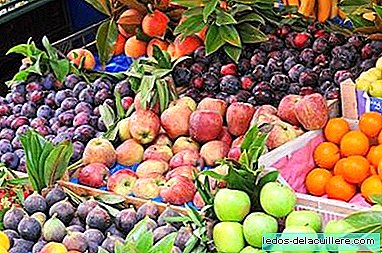
Fruits are edible fruits that come from cultivated or wild plants. They constitute an essential food group for health and therefore occupy the second place in the food pyramid together with vegetables.
The main advantages of fruits in infant feeding is that they provide a high water content (between 80 and 95%), in vitamins and minerals and have a low calorie intake. They contain vegetable fibers, simple carbohydrates and no fat.
The data show that Spanish children eat little fruit, to change that trend it is recommended to include between two and four pieces each day in the children's menu. They should be present at breakfast, as a dessert and as a snack.
Fruits are irreplaceable in the diet of the little ones because they provide a sugar that is very easy to assimilate by the body, providing them with the energy they need each day and avoiding the consumption of unhealthy foods rich in fats and artificial sugars.
In turn, they provide micronutrients and antioxidants that act as a shield against possible diseases such as obesity, constipation, hypertension, cancer and cardiovascular problems.
Fruit classification
Fruits can be classified according to the type of seed it contains in:
- Stone fruits (carozo): those that have a large and hard-shell seed, such as apricot, peach, plum, nectarine, cherry.
- Pomegranate or pomaceous fruits: those that have several small, less hard-shell seeds such as pear and apple.
- Grain fruits: those that contain small seeds such as fig, kiwi.
Other classifications are also known as:
Rosaceae fruits: They come from plants or trees of the Rosaceae family. Among them are the ones we consume most commonly such as apple, pear, peach, apricot, plum, cherry, strawberry, quince.
Citric fruits: They have a high content of vitamin C and citric acid, hence their characteristic flavor. In this group we find orange, tangerine, lemon, lime and grapefruit.
Tropical fruits: Although they are not only grown in the tropics, they are those that need heat and humidity to develop. We found: banana, kiwi, mango, papaya, pineapple, guava, coconut.
Forest or wild fruits: they are wild fruits that grow in the forests, although nowadays they are also grown. They are raspberry, blueberries, blackberry, redcurrant, blackberry.
Nuts: they are those fruits in whose composition there is less than half of water. They are characterized by having great energy value, being rich in fats, proteins and trace elements. Among them we find hazelnut, chestnuts, almonds and walnuts.

When to introduce fruits
Fruits can begin to be offered as complementary food, that is, by supplementing breast milk or formula, from 6 months.
Some are more suitable to offer before others because they have a lower risk of developing allergies in children. They should be introduced into the diet one by one to check their tolerance and wait two or three days to offer a new one.
Let's look carefully at what age each fruit can be offered.
- At 6 months: Apple, pear, banana, plum, cherry (without bone), grapes (without skin or pips), kiwi and pineapple (if the baby accepts them). Melon, watermelon, papaya and mango can be offered at 6 months, but for its too sweet taste it is preferable to start with other fruits and leave them for a little later.
With respect to orange and tangerine, there are pediatricians who also recommend introducing them at 6 months, while others suggest waiting until 12 months to consider the most allergenic citrus.
- At 12 months: Peach, apricot, medlar. There are those who recommend appropriate red fruits to offer from the year, however others consider them too allergic and recommend them from 15-18 months.
- From 24 months: nuts
How to prepare the fruits
When buying it, we should always choose slightly ripe fresh fruit. At the time of eating them, the natural one is the best way to take advantage of all the nutritional benefits that the fruit offers us, however when we talk about babies we will have to start offering them without skin and of course, without bone (carozo), grains or pips .
The ways in which we can offer children fruits are very diverse. Al natural or converted into juices, sorbets, fruit salad, smoothies, compotes, purees and later in yogurts or jellies.
At first, it is best to offer it in purees so that the baby accepts them better, or they can be offered in the hand cut into small pieces for the child to experiment. For this, fruits that fall apart like bananas or pears are ideal if they are very ripe, and if it is harder fruit such as apple, it is preferable to offer pieces the size of the baby's fist so that when sucking and nibbling it, even if Do not have teeth, it is falling apart (there are also anti-choking nets). For those who want to know more about this modality based on the baby's ability to experiment with food, you can check what we have published about Baby led weaning.
The smallest can also be offered in the form of juices, but better in teaspoons to avoid the habit of drinking sugary juice in a bottle which causes tooth decay.
Be that as it may, you always have to wash them very well before giving them to the baby and at first offer them peeled. You have to prepare and consume them right away so that the fruit does not start to oxidize and lose its vitamin intake.
Do not add sugar or crushed cookies to the first fruit porridge. One option, once it is proven that the baby tolerates the mash well, is to add a couple of tablespoons of cereals (with or without glute, depending on the age of the baby) to make it tastier.
However, it is best not to "disguise" the flavors of the fruit, and although it is best to offer it to the natural, for the first purees you can poach the fruit in boiling water for 2 minutes to make it better accepted.
Photos | Tambako The Jaguar, Automanía on Flickr
In Babies and more | Hello spoon !: first fruit porridge, Summary guide of complementary feeding (I), Summer fruits: characteristics and recommendations, Fruits suitable for children












